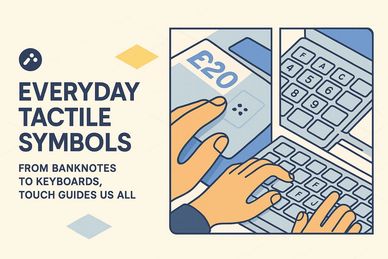Tactile Symbols

Imagine going through your daily routine, unsure which product to grab. With tactile symbols on packaging, you can quickly identify what you need, empowering you to take charge of your self-care without second-guessing.
As sight loss becomes more common, the need for accessible product identification is critical. For those with low vision, telling similar-looking bottles apart can be a real headache. Think about it: salt and pepper, ketchup and mayo—often packaged the same way! It’s all too easy to accidentally grab the wrong one.
With around 2.2 billion people experiencing low vision and 283 million living with blindness, clear and accessible packaging is essential. Shockingly, only 10% of blind individuals can read Braille, leaving many struggling to identify everyday items on their own. Research shows blind consumers can spend up to 30 minutes trying to make a product accessible, often resorting to makeshift solutions like elastic bands or ‘bump’ stickers. Plus, many still need help from others to find products both in stores and at home. It’s time we change that!

Tactile symbols are innovative, sensory markers designed to provide individuals with visual impairments a means to identify products independently. By incorporating simple shapes and textures—such as stripes, circles, and other tactile cues—into product packaging, we can facilitate easier recognition of items. For instance, a tactile circle might signify a moisturizer, while a series of stripes could represent a shampoo. These symbols serve as intuitive guides, empowering users to navigate their personal care routines confidently.
Tactile symbols have already been largely used throughout our society. In the UK, banknotes have tactile symbols. So do ATM machines and even computer / laptop keyboards.

Tactile Symbols are Needed because of:
- Enhanced Independence: Tactile symbols allow blind and low-vision individuals to identify products without relying on assistance or technology, fostering a greater sense of autonomy in their daily lives.
- Universal Accessibility: With less than 10% of blind individuals reading Braille, tactile symbols offer a universal alternative that can be understood by a wider audience. This inclusivity aligns with the growing awareness among consumers regarding disability accessibility.
- Meeting Market Demands: As brands increasingly recognize the importance of inclusivity, tactile symbols resonate with younger generations—78% of whom prefer brands that align with their values. Additionally, as the aging population grows, the demand for accessible products continues to rise.
- Overcoming Language Barriers: Tactile symbols are language-agnostic, allowing anyone—regardless of their language proficiency—to identify the right product easily. This feature enhances accessibility for a diverse user base.
This is how it all began...
Universal Tactile System
To address these challenges, Procter & Gamble (P&G) has pioneered the Universal Tactile System, which introduces tactile symbols to product packaging. This innovative system offers a straightforward solution for consumers, allowing them to easily identify products through touch.
What's remarkable about the Universal Tactile System is its open-source nature, which means that any manufacturer can adopt and implement these tactile symbols in their own products. This initiative presents an exciting opportunity for companies in the consumer goods sector to enhance accessibility for their customers.
For those in industries where tactile symbols have yet to be developed, I encourage you to reach out for consultation. Collaborating with blind and low-vision individuals can provide valuable insights into creating effective solutions that meet their needs.
If you are blind or have low vision, there are already products available in the market that incorporate these tactile features. We invite you to explore these options and experience the benefits of greater independence and ease in your daily life. Together, we can create a more inclusive world where everyone can navigate their surroundings confidently and effortlessly.